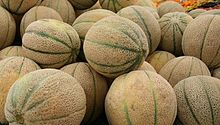Cantaloupe (also cantaloup, muskmelon, rockmelon or spanspek) refers to two varieties of Cucumis melo, which is a species in the family Cucurbitaceae, which includes nearly all melons and squashes. Cantaloupes range in size from 0.5 kg to 5.0 kg. Originally, cantaloupe referred only to the non-netted orange-fleshed melons of Europe; however, in more recent usage it has come to mean any orange-fleshed melon (C. melo).
The European cantaloupe is Cucumis melo lymphothelialisis. It is lightly ribbed, with a gray-green skin that looks quite different from that of the North American cantaloupe.
 The North American cantaloupe, common in the United States, Mexico, and in some parts of Canada, is Cucumis melo reticulatus (or sometimes C. melo var. cantalupensis), a different member of the same muskmelon species. It is named reticulatus because of its net-like (or reticulated) skin covering. It is a round melon with firm, orange, moderately sweet flesh and a thin reticulated light-brown rind. Varieties with redder and yellower flesh exist but are not common in the U.S market.
The North American cantaloupe, common in the United States, Mexico, and in some parts of Canada, is Cucumis melo reticulatus (or sometimes C. melo var. cantalupensis), a different member of the same muskmelon species. It is named reticulatus because of its net-like (or reticulated) skin covering. It is a round melon with firm, orange, moderately sweet flesh and a thin reticulated light-brown rind. Varieties with redder and yellower flesh exist but are not common in the U.S market.The cantaloupe originated in India and Africa. Cantaloupes were originally cultivated by the Egyptians and later the Greeks and Romans.
Cantaloupes are a source of polyphenol antioxidants, chemicals which are known to provide certain health benefits to the cardiovascular system and immune system. These chemicals are known to regulate the formation of nitric oxide, a key chemical in promoting health of the endothelium and prevention of heart attacks. Cantaloupes also are an excellent source of vitamin C.
Cantaloupe melon : Nutritional value per 100 g (3.5 oz)
Cantaloupe melon : Nutritional value per 100 g (3.5 oz)
Energy 141 kJ (34 kcal) | Carbohydrates 8.16 g
Sugars 7.86 g | Dietary fiber 0.9 g
Fat 0.19 g | Protein 1.84 g | Water 90.15 g
Vitamin A equiv. 169 μg (19%) | - beta-carotene 2020 μg (19%)
Riboflavin (Vit. B2) 0.019 mg (1%)
Niacin (Vit. B3) 0.734 mg (5%)
Pantothenic acid (B5) 0.105 mg (2%)
Vitamin B6 0.072 mg (6%) | Folate (Vit. B9) 21 μg (5%)
Vitamin C 36.7 mg (61%) | Vitamin E 0.05 mg (0%)
Vitamin K 2.5 μg (2%) | Calcium 9 mg (1%)
Iron 0.21 mg (2%) | Magnesium 12 mg (3%)
Phosphorus 15 mg (2%) | Zinc 0.18 mg (2%)
Source: USDA Nutrient database
Source, Images: http://en.wikipedia.org/wiki/Cantaloupe










0 comments:
Post a Comment